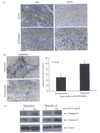Anti-EMMPRIN antibody treatment of head and neck squamous cell carcinoma in an ex-vivo model
- PMID: 20700044
- PMCID: PMC4052458
- DOI: 10.1097/CAD.0b013e32833d1a11
Anti-EMMPRIN antibody treatment of head and neck squamous cell carcinoma in an ex-vivo model
Abstract
Targeting the molecular pathways associated with carcinogenesis remains the greatest opportunity to reduce treatment-related morbidity and mortality. Extracellular matrix metalloproteinase inducer (EMMPRIN), also known as CD147, is a cell surface molecule known to promote tumor growth and angiogenesis in preclinical studies of head and neck carcinoma making it an excellent therapeutic target. To evaluate the feasibility of anti-EMMPRIN therapy, an ex-vivo human head and neck cancer model was established using specimens obtained at the time of surgery (n=22). Tumor slices were exposed to varying concentrations of anti-EMMPRIN monoclonal antibody and cetuximab for comparison purposes. Cetuximab is the only monoclonal antibody currently approved for the treatment of head and neck carcinoma. After treatment, tumor slices were assessed by immunohistochemistry and western blot analysis for apoptosis (TUNEL) and EMMPRIN expression. Of the tumor specimens 33% showed a significant reduction in mean ATP levels after treatment with cetuximab compared with untreated controls, whereas 58% of the patients responded to anti-EMMPRIN therapy (P<0.05). Samples, which showed reactivity to anti-EMMPRIN, also had greater EMMPRIN expression based on immunohistochemistry staining (49%) when compared with nonresponders (25%, P=0.06). In addition, TUNEL analysis showed a larger number of cells undergoing apoptosis in antibody-treated tumor slices (77%) compared with controls (30%, P<0.001) with activation of apoptotic proteins, caspase 3 and caspase 8. This study shows the potential of anti-EMMPRIN to inhibit proliferation and promote apoptosis and suggests its future role in the targeted treatment of head and neck carcinoma.
Figures




Similar articles
-
Anti-EMMPRIN monoclonal antibody as a novel agent for therapy of head and neck cancer.Clin Cancer Res. 2009 Jun 15;15(12):4058-65. doi: 10.1158/1078-0432.CCR-09-0212. Epub 2009 Jun 9. Clin Cancer Res. 2009. PMID: 19509148 Free PMC article.
-
Anti-EMMPRIN treatment of HNSCC in an ex vivo model.Laryngoscope. 2010;120 Suppl 4:S146. doi: 10.1002/lary.21610. Laryngoscope. 2010. PMID: 21225744 No abstract available.
-
Modulation of tumor cell growth in vivo by extracellular matrix metalloprotease inducer.Arch Otolaryngol Head Neck Surg. 2008 Nov;134(11):1218-24. doi: 10.1001/archotol.134.11.1218. Arch Otolaryngol Head Neck Surg. 2008. PMID: 19015455 Free PMC article.
-
Cetuximab: an epidermal growth factor receptor chemeric human-murine monoclonal antibody.Drugs Today (Barc). 2005 Feb;41(2):107-27. doi: 10.1358/dot.2005.41.2.882662. Drugs Today (Barc). 2005. PMID: 15821783 Review.
-
The role of cetuximab in the treatment of squamous cell cancer of the head and neck.Expert Opin Biol Ther. 2005 Aug;5(8):1085-93. doi: 10.1517/14712598.5.8.1085. Expert Opin Biol Ther. 2005. PMID: 16050785 Review.
Cited by
-
Hypoxia, cancer metabolism and the therapeutic benefit of targeting lactate/H(+) symporters.J Mol Med (Berl). 2016 Feb;94(2):155-71. doi: 10.1007/s00109-015-1307-x. Epub 2015 Jun 24. J Mol Med (Berl). 2016. PMID: 26099350 Free PMC article. Review.
-
New insights into germ cell migration and survival/apoptosis in spermatogenesis: Lessons from CD147.Spermatogenesis. 2012 Oct 1;2(4):264-272. doi: 10.4161/spmg.22014. Spermatogenesis. 2012. PMID: 23248767 Free PMC article.
-
CD147 knockdown improves the antitumor efficacy of trastuzumab in HER2-positive breast cancer cells.Oncotarget. 2016 Sep 6;7(36):57737-57751. doi: 10.18632/oncotarget.10252. Oncotarget. 2016. PMID: 27363028 Free PMC article.
-
CD147 Is a Promising Target of Tumor Progression and a Prognostic Biomarker.Cancers (Basel). 2019 Nov 16;11(11):1803. doi: 10.3390/cancers11111803. Cancers (Basel). 2019. PMID: 31744072 Free PMC article. Review.
-
Immunotherapy for head and neck cancer: advances and deficiencies.Anticancer Drugs. 2011 Aug;22(7):674-81. doi: 10.1097/CAD.0b013e328340fd18. Anticancer Drugs. 2011. PMID: 21037467 Free PMC article. Review.
References
-
- Jemal A, Siegel R, Ward E, Murray T, Xu J, Thun MJ. Cancer statistics, 2007. CA Cancer J Clin. 2007;57:43–66. - PubMed
-
- Silverman S., Jr Demographics and occurrence of oral and pharyngeal cancers. The outcomes, the trends, the challenge. J Am Dent Assoc. 2001;132(Suppl):7S–11S. - PubMed
-
- Gold KA, Lee HY, Kim ES. Targeted therapies in squamous cell carcinoma of the head and neck. Cancer. 2009;115:922–935. - PubMed
-
- Bonner JA, De Los Santos J, Waksal HW, Needle MN, Trummel HO, Raisch KR. Epidermal growth factor receptor as a therapeutic target in head and neck cancer. Semin Radiat Oncol. 2002;12:11–20. - PubMed
-
- Bonner JA, Harari PM, Giralt J, Azarnia N, Shin DM, Cohen RB, et al. Radiotherapy plus cetuximab for squamous-cell carcinoma of the head and neck. N Engl J Med. 2006;354:567–578. - PubMed
Publication types
MeSH terms
Substances
Grants and funding
LinkOut - more resources
Full Text Sources
Medical
Research Materials

